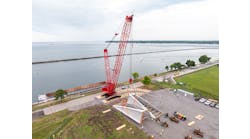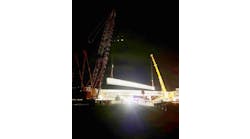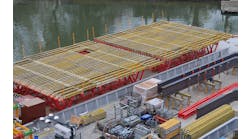By: Bill Wilson
Texans know how to win over people. Three U.S. presidents
have done it on a mass scale over the past 35 years.
But Lyndon Johnson, George Bush and George W. Bush never
jumped in front of cars during morning and evening commutes asking for support.
The Texas Department of Transportation (TxDOT) is trying to accomplish approval
victory on a grand scale with the construction of the Dallas High Five
interchange—which will sit in an area that attracts a bewildering 500,000
vehicles daily. Two major highways, U.S. 75 (North Central Expressway) and
I-635 (LBJ Freeway), are the two main carriers, and effective traffic
management during the creation of Dallas’ first five-level road structure
has been the top promise since day one.
The numbers are big. The $260 million project (a TxDOT
record) will involve 43 bridges covering 2.3 million sq ft, 630 columns and
591,000 sq ft of concrete paving. The longest bridge will be more than two
miles and the height of the tallest column is set at 115 ft. Construction
officially began back in January, but work has been going on since August 2001.
The finish target is 2007.
Currently, the interchange operates on three levels.
Eastbound I-635 is the lowest level, U.S. 75 north and southbound is level two
and at the top is westbound I-635. The design is a modified cloverleaf, one
that has two of the four exit-ramps. The problem with this system is motorists
have to slow down dramatically when turning around the loop ramps, thus backing
up traffic onto U.S. 75 and clogging the main lanes.
Forming the new five will be, from bottom to top, U.S. 75
main lanes, frontage road box carrying east, west, north and southbound cross
streets, I-635 main lanes, direct connection bridges (two levels). The direct
connection ramps will eliminate the modified cloverleaf.
TxDOT and prime contractor Zachry Construction Corp., San
Antonio, Texas, will work in a total of three phases. Phase I includes work on
TI Blvd.; Hillcrest Road and Park Central drive U-turns; Coit Road Bridge; U.S.
75 and I-635 frontage roads; direct connection ramps between freeways; Midpark
Road and TI Blvd. access bridges; HOV wishbone ramps on U.S. 75 and the
Greenville Ave. U-turn. During Phase II crews will be constructing I-635 main
and HOV lanes, a frontage road box along U.S. 75 and HOV T-connection ramps at
TI Blvd. U.S. 75 main lanes, the frontage road box along I-635 and a reversible
HOV direct connection ramp will be worked on in Phase III.
“If you talk to the public it’s like, ‘How
in the world are you going to build this five-level interchange and keep
traffic flowing through these two highways?’” Wallace Heimer,
director of structures for HNTB Corp., Plano, Texas, told Roads & Bridges.
HNTB is the principal designer of the Dallas High Five.
Every day will be a holiday
The fight with traffic around the Dallas area can sometimes
feel like the Battle of Gettysburg. In terms of time, there are many
casualties. The U.S. 75/I-635 interchange has received an ‘F’
grade, which translates into the lowest possible level of service. Lane
configuration is the main reason behind the poor showing. The north and south
ends of U.S. 75 were recently widened to four lanes in each direction, but once
you hit the interchange the number bottlenecks to two. The Dallas High Five
will open U.S. 75 to a total of eight lanes (four in each direction) and I-635
will be improved to 10 lanes of travel and four dedicated barrier-separated HOV
lanes.
“In the morning and evening peaks you’re looking
at stop-and-go traffic in all four directions on most typical days,” said
Heimer. “If there was a holiday you might have a little better shot of
getting through there.”
To keep traffic advancing during construction Zachry is
laying “detour” asphalt pavement. When work begins on a particular
section, traffic is moved off to the left or right. When it’s complete,
the flow moves to the new concrete road.
“That’s generally how it’s been
accomplished, we’ll scoot everybody over to one side either completely on
the existing pavement, a combination of existing and detour pavement or all on
detour pavement,” said Heimer.
Five temporary bridges will be built to maintain the
multi-level traffic configuration. The spans will be parallel to the existing
bridges and “could last 35 to 40 years if they were left in place,”
said Heimer. “They have the same engineering, utilize the same material,
go through the same testing.” The only drawback is the cost to construct
these short-term bridges is the same as those of the long-term variety. Two of
the five carrying U.S. 75 north and south over eastbound I-635 are already in
place but were not yet open to traffic as of May 24.
Adding to the importance of traffic flow is TxDOT’s
lane rental charge. Zachry will be charged an hourly lane rental fee for every
main freeway lane closure, with the fees varying by time of day. The contractor
could be charged up to $110,000 an hour for a triple-lane closure during peak
travel times.
To answer the call, Zachry plans to perform one-third of the
work at night. The biggest closure so far happened back in January when half of
an existing utility bridge was demolished and required I-635 to be completely
shut down. Eastbound lanes were closed on Friday night, westbound lanes Saturday
night. Work started around 9 p.m. and was completed by 5 a.m. the next day.
Heavy air traffic
If the Dallas High Five had an ego it would be the columns.
And some are quite inflated. The tallest is 115 ft and will stand right in the
middle of the interchange. The base will be next to U.S. 75, the lowest level,
and the top will support one of the connectors.
Finding solid ground for the footings wasn’t a problem
in Dallas. In some areas rock is only about 7 ft down, and the maximum depth
was 30-35 ft.
“It made the design simpler,” said Heimer.
“For the most part the footing was in the rock, it basically locked the
bottom of the column.”
All 620 reinforced concrete columns will be cast in place
using steel formwork, and as of press time 125 were complete.
Most of the spans on the projects will have prestressed
concrete U-beams, which were the center of a minor debate during the planning stages.
TxDOT and HNTB looked at three different structure alternatives—I-beam
concrete girders, steel-plate girders and the U-beams. All three were evaluated
on cost and aesthetics, and in the end TxDOT chose the U-beams.
“U-beams are more expensive per beam but you can space
them further apart,” said Heimer. The U-beams will be precast in San
Antonio, about 300 miles from the jobsite.
The chosen design also carries a lot of weight, about twice
as much as the standard AASHTO I-beam. Smaller beams can be placed with one
crane, but the larger ones will require two. Due to the tight space constraints
of the interchange, crane placement could be a problem down the line. But so
far the only tricky situation came in mid-May when crews were installing
U-beams over Dallas’ DART rail line by TI Blvd. Lines had to be
“de-energized” so work could be completed.
“It’s been smooth,” Pete Garza, project
engineer manager for TxDOT, told Roads & Bridges. “We have to just
communicate with each other as far as what we’re doing and what
we’re planning to do.”
Positive progress has been made. U-beams have been installed
on the Coit Road Bridge and on the south side of I-635 from TI Blvd. to
Greenville Ave. Placement on the north side looked to be complete by June.
Garza said crews were supposed to begin concrete deck pouring by mid-June.
U-beams, however, will not cover the entire Dallas High
Five. Post-tensioned concrete segmental trapezoidal box spans—25 of
them—will be used in the heart of the interchange, where spans stretch out
to 300 ft. TxDOT acquired additional right-of-way so pieces could be precast in
the southwest quadrant. Match-casting, where pieces are cast together and then
separated, will take place, and the balanced cantilever method will be used
during erection. The segmental bridges also will have an 8-ft overhang, or
“wing.” Prestressing strands will act as reinforcement for the
wings, and additional support will come from post-tensioned ducts, both
transverse and longitudinal.
All structures will use high-performance concrete ranging
from 4,000 to 6,500 psi.
The road surface is designed to be continuous reinforced
concrete 14 in. thick.
TxDOT is using maturity testing by inserting an electrode
that reads the temperature and strength of the concrete at any given time.
Cylinders are used to test for compressive strength, and TxDOT will perform
“cylinder breaks” all the way up to 28 days.
The frontage road system is being revamped. Under the old
system frontage roads skirt around the perimeter of the interchange and
motorists utilize cross streets in the four quadrants to get across the
highway. The new frontage road box will create a “straight shot”
through the area.
The Dallas High Five will have other quick alternatives. One
of the major connector ramps will be for high-occupancy vehicles which will
connect U.S. 75 north of the interchange to the HOV lane on I-635 west. This
particular type of ramp is a first in the Dallas area.
Dressing up
When work is finished, everyone involved wants the Dallas
High Five to look acceptable.
Large Texas stars will protrude from the tops of the
columns. The stars are actually cast into the concrete using a form liner. The
tallest will have brass stars with fiber-optic lighting. Three painted
metal-accented stripes will run up the columns.
Scenic retaining walls will be installed throughout the
project. Garza has already seen ones with a rolling creek. Other designs are
yet to be unveiled.
Work on the interchange is about 10% complete and has gone
without any major letdown, which doesn’t surprise Garza. TxDOT worked
with Zachry on the U.S. 75 reconstruction project which was the largest job
before the Dallas High Five.
Zachry could earn $32,000 a day up to a year for an early finish.
About The Author: Bill Wilson is editor of Roads & Bridges.


